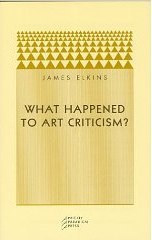What Happened to Art Criticism?
by James Elkins
Most museum stores are deplorable, especially those noisy souvenir stands they throw across the exit of costly blockbuster exhibits, touting coasters, toys, and playing cards as accessories to the elegant life. I’ve noticed lately that some of the larger contemporary museums, notably San Francisco and Chicago, possess stores that one might choose to enter.
And so yesterday’s brief downpour found me leaving the SFMOMA store with a copy of James Elkins’ tiny What Happened to Art Criticism?
He sets out to decipher
[the] fascinating mystery that art criticism has turned so abruptly from the engaged, passionate, historically informed practice it was before the late twentieth century, into the huge, massively funded but invisible and voiceless practice it has effectively become.
Elkins acknowledges that opposition to contemporary criticism has often stemmed from the reactionary right and from nostalgia for an imaginary past. After Bush, those forces perhaps are spent; in the academy, at least, we know again that knowledge and skill are useful and desirable things to have. But Elkins is haunted by phantom criticism for phantom audiences:
Critics seldom know who reads their work beyond the gallerists who commission it and the artists about whom they write: and often that reading public is ghostly precisely because it does not exist. A ghostly profession, catering for ghosts, but in a grand style.
